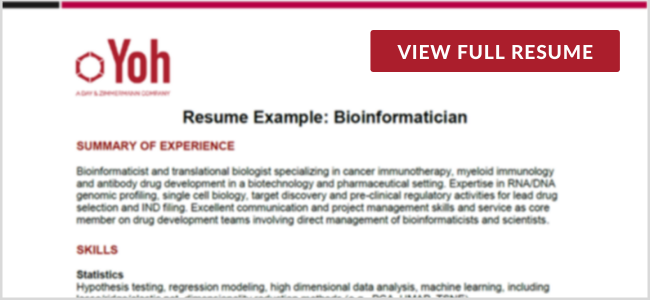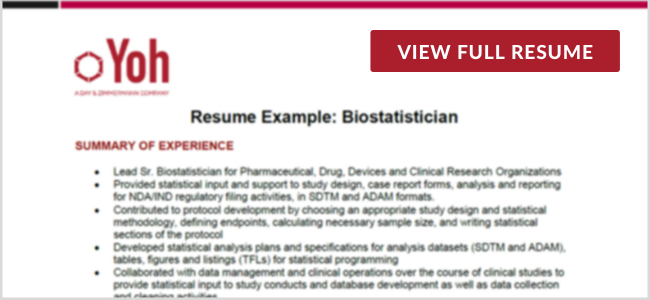
It takes highly skilled talent to work on sensitive projects such as those in any biopharmaceutical lab. Today, roles that combine skillsets in both technology and science are extremely “hot.” Having the right mix of each can differentiate a person from the rest of the talent pool. For organizations hiring these technical positions, it all comes down to how quickly you can move that talent through the hiring process. Since it’s such a niche market, it takes knowledgeable recruiters with industry experience to fill your lab with the talent you need.
Here are three common roles that are making waves (and scientific breakthroughs!) in the Biopharmaceutical industry today.
1. CLINICAL DATA MANAGER
Clinical Data Managers apply knowledge of healthcare and database management to analyze clinical data and identify and report trends. They also design and validate clinical databases, including designing or testing logic checks. Their role in the lab is to ensure that statistical information and results from clinical trials are recorded accurately by developing and executing data testing and analysis plans, ensuring robust data quality and identifying ways to improve processes. And that’s a pretty big job!
Their typical career progression and growth may begin with roles such as Clinical Database Designer, Clinical Data Entry Operator, or Clinical Data Validator. From there, they could move up to positions such as Clinical Data Manager, SAS Programmer, or Statistician. Finally, they might accept titles like Lead Clinical Data Manager or Head of Clinical Data Management with more applied experience.
On their resumes, some common keywords might include Clinical Data Management (CDM), Clinical Data Interchange Standards Consortium (CDISC), the International Council for Harmonisation of Technical Requirements for Pharmaceuticals for Human Use (ICH), Electronic Data Capture (EDC), as well as SAS, Tableau, SQL, R, and Python.
2. BIOINFORMATICIAN or BIOINFORMATICS SCIENTIST
Bioinformatics is a field of computational science that analyzes sequences of biological molecules. It usually refers to genes, DNA, RNA, or protein and is particularly useful in comparing genes and other sequences in proteins within an organism or between organisms. This field takes a hard look at evolutionary relationships between organisms and uses patterns that exist across DNA and protein sequences to determine their function. Because of that, it’s also a competitive field to hire within.
There are three common Bioinformatics career paths in a clinical lab, each requiring a specific mix of education and experience.
- Researcher - Many research paths do lead to industry jobs, but these tend to morph into analyst or engineer-type roles.
- Bioinformatics Analyst – This role focuses more on analyzing data for scientists or performing their own analyses. Lab skills aren’t essential, but they need familiarity with protocols in the biological field.
- Bioinformatics Engineers/Developers – These roles write the software tools used by analysts and researchers, and some may perform research themselves. Being a Bioinformatics Engineer or Bioinformatics Developer requires a deep understanding of algorithms, data structures, software engineering, and high-performance computing. However, good programming skills and a desire to learn the science are enough to get started.
While each lab is unique in what they’re seeking in the perfect Bioinformatician, some must-haves to get hired in the Bioinformatics space include:
- Bioinformatics and programming skills
- Varying levels of biology knowledge, such as molecular biology, genetics, and cancer biology.
- Knowledge of genomics and genetics, which is the core of bioinformatics. More specifically, candidates need knowledge of high-throughput sequencing, next-generation sequencing, and computational genomics.
- Data mining and machine learning (ML)
In addition, the most common keywords on their resumes include Python, SAS, R, Perl, Java, Matlab, SPSS, Molecular Biology, Cancer Biology, Genomics, and Genetics.
3. BIOSTATISTICIAN
Despite their similar-sounding titles, a distinct difference exists between Bioinformatics vs. Biostatistics, and the same goes for the roles in each sector. While Bioinformatics is more closely related to the biological data and tracking the trending, Biostatistics roles work on broader, bigger-picture data. Unfortunately, both are extremely competitive and require a high level of expertise from recruiters.
Anytime statistics like “75% of people who smoke develop lung cancer" are heard, one can be sure that the hard work of a Biostatistician was behind it. They analyze and study the determining factors that impact the health and well-being of people, plants, and animals to arrive at conclusions about disorders, diseases, or other health risks. With this information, a Biostatistician can study the effects of various treatments based on the findings and numbers of the analysis. Biostatisticians apply mathematics, statistics, and data to biology. They collect, analyze, and interpret the data they collect during biological research to draw conclusions in the areas of medicine and agriculture. A Biostatistician is a critical addition to any research team and often involved in the writing of papers on groundbreaking topics and research.
Their career progression and growth is highly dependent on varying levels of education and applied experience. However, working as a full-fledged Biostatistician usually requires a master’s-level education in Biostatistics or a closely related field. Some of the top roles at each level include:
- Bachelor’s Degree - Data Manager, Data Analyst, Research Technician, Study Coordinator, Clinical Research Associate
- Master’s Degree - Biostatistician, Data Analyst, Bioinformatician, Senior Data Manager
- Doctoral - Professor of Biostatistics, Clinical Researcher, Senior Biostatistician
To get hired in this sector, candidates must have skills in statistics, problem-solving, written and oral communication (especially the ability to communicate to non-statisticians), industry knowledge, computer background, and programming. On their resumes, some common keywords include SAS, Data Analysis, R, Study Design, Clinical Trials, Data Management, and Mathematics.
Interested in Life Sciences roles? Find out more in my blog What Does a Data Scientist Really Do?





